Forensic Investigation: How Emerging Technologies Benefit Processes?
VerifiedAdded on 2023/06/04
|10
|1987
|414
Report
AI Summary
This research proposal delves into the realm of forensic investigation, focusing on the transformative impact of emerging technologies. It addresses existing gaps in current research outcomes and poses the central question of how these technologies can benefit forensic investigation processes. A mixed methodology, incorporating both primary and secondary research, is proposed, including a questionnaire survey among forensic investigators to gather data on the utilization and future enhancement of these technologies. The research timeline outlines key phases, from research initiation and planning to execution, scenario deployment, and closing, with a focus on data collection, qualitative analysis, and computer simulation regarding digital forensics. The proposal also includes a literature review, referencing various studies on the application of technologies like cloud computing, Laser Ablation Inductively Coupled Plasma Mass Spectrometry (LAICP-MS), and DNA sequencing in forensic science, highlighting their role in enhancing data analysis and criminal identification.
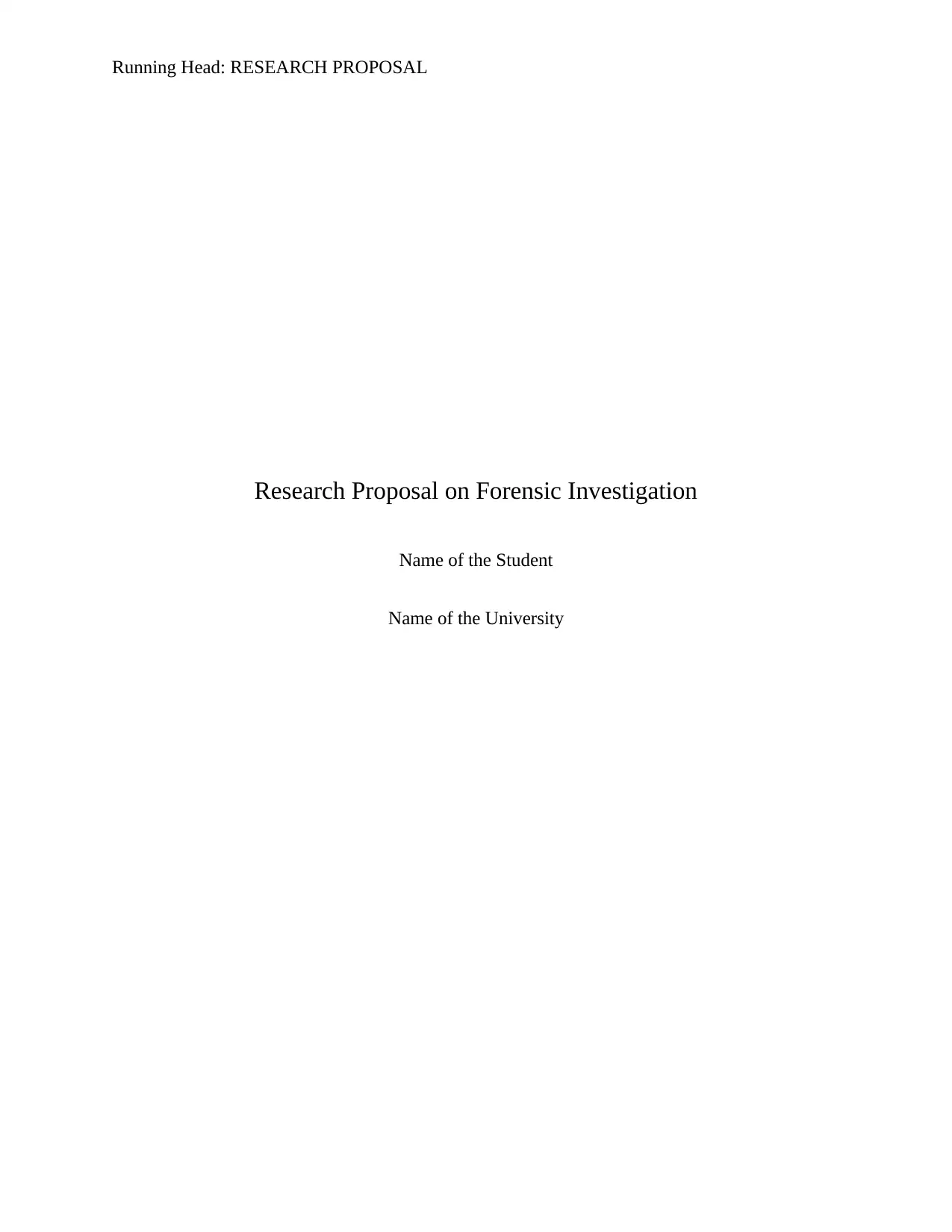
Running Head: RESEARCH PROPOSAL
Research Proposal on Forensic Investigation
Name of the Student
Name of the University
Research Proposal on Forensic Investigation
Name of the Student
Name of the University
Paraphrase This Document
Need a fresh take? Get an instant paraphrase of this document with our AI Paraphraser
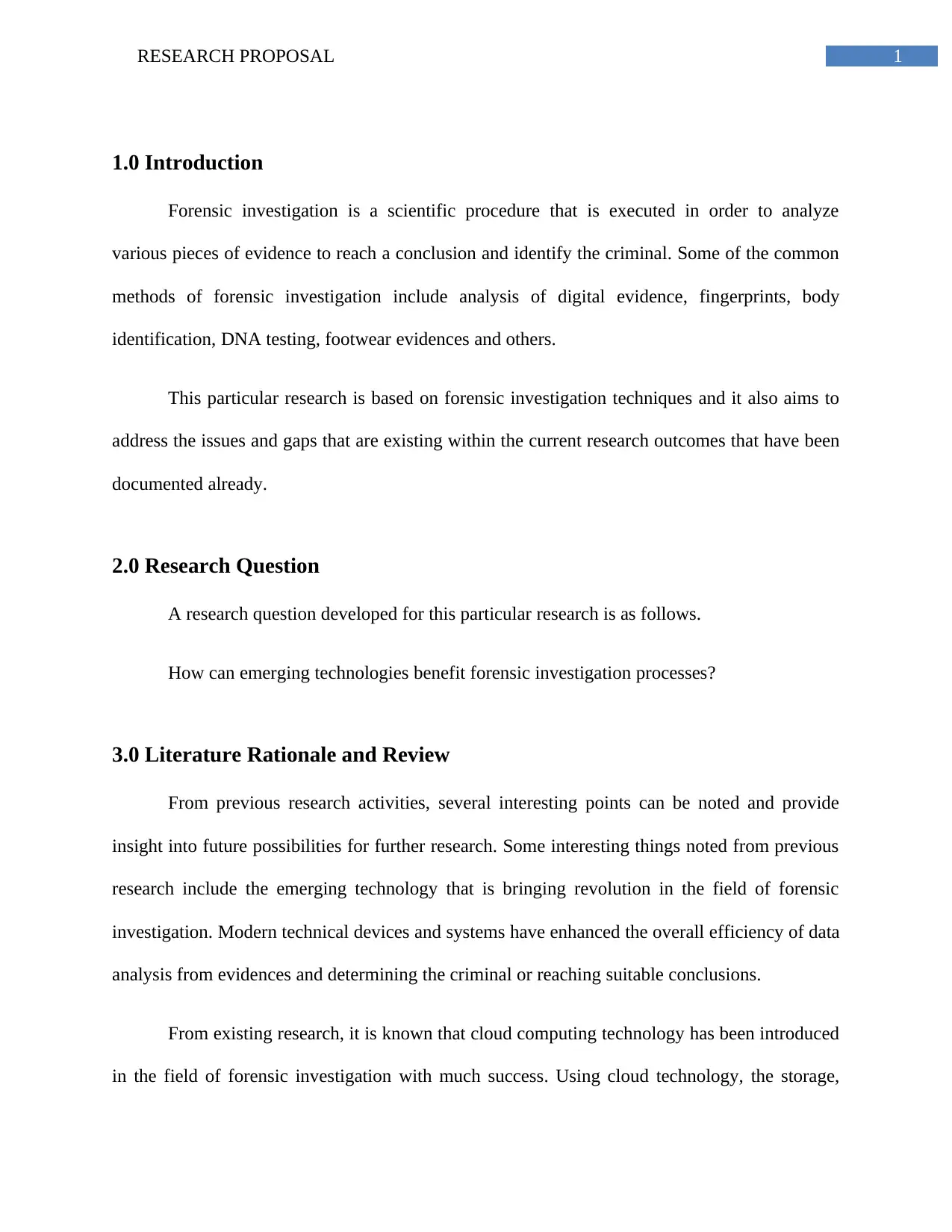
1RESEARCH PROPOSAL
1.0 Introduction
Forensic investigation is a scientific procedure that is executed in order to analyze
various pieces of evidence to reach a conclusion and identify the criminal. Some of the common
methods of forensic investigation include analysis of digital evidence, fingerprints, body
identification, DNA testing, footwear evidences and others.
This particular research is based on forensic investigation techniques and it also aims to
address the issues and gaps that are existing within the current research outcomes that have been
documented already.
2.0 Research Question
A research question developed for this particular research is as follows.
How can emerging technologies benefit forensic investigation processes?
3.0 Literature Rationale and Review
From previous research activities, several interesting points can be noted and provide
insight into future possibilities for further research. Some interesting things noted from previous
research include the emerging technology that is bringing revolution in the field of forensic
investigation. Modern technical devices and systems have enhanced the overall efficiency of data
analysis from evidences and determining the criminal or reaching suitable conclusions.
From existing research, it is known that cloud computing technology has been introduced
in the field of forensic investigation with much success. Using cloud technology, the storage,
1.0 Introduction
Forensic investigation is a scientific procedure that is executed in order to analyze
various pieces of evidence to reach a conclusion and identify the criminal. Some of the common
methods of forensic investigation include analysis of digital evidence, fingerprints, body
identification, DNA testing, footwear evidences and others.
This particular research is based on forensic investigation techniques and it also aims to
address the issues and gaps that are existing within the current research outcomes that have been
documented already.
2.0 Research Question
A research question developed for this particular research is as follows.
How can emerging technologies benefit forensic investigation processes?
3.0 Literature Rationale and Review
From previous research activities, several interesting points can be noted and provide
insight into future possibilities for further research. Some interesting things noted from previous
research include the emerging technology that is bringing revolution in the field of forensic
investigation. Modern technical devices and systems have enhanced the overall efficiency of data
analysis from evidences and determining the criminal or reaching suitable conclusions.
From existing research, it is known that cloud computing technology has been introduced
in the field of forensic investigation with much success. Using cloud technology, the storage,
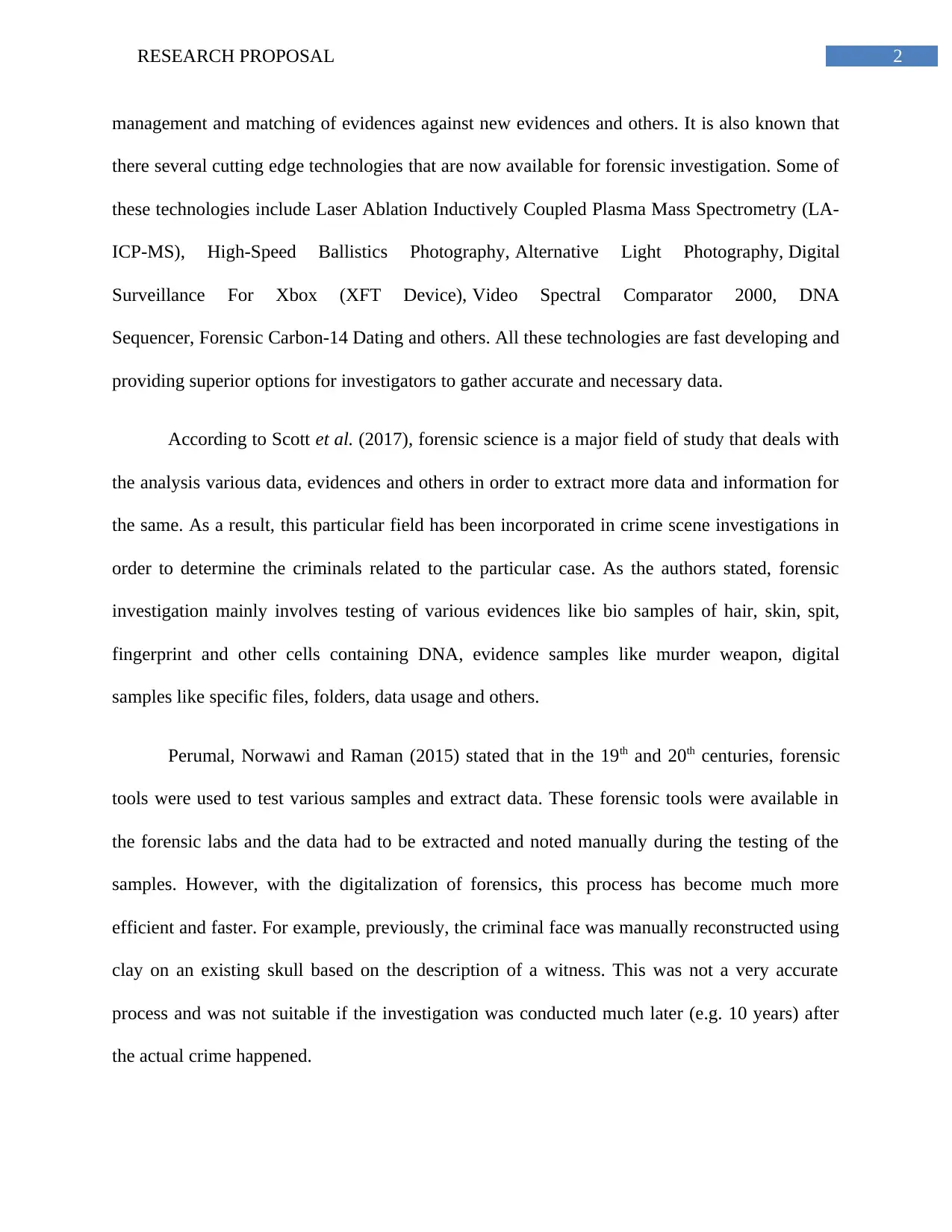
2RESEARCH PROPOSAL
management and matching of evidences against new evidences and others. It is also known that
there several cutting edge technologies that are now available for forensic investigation. Some of
these technologies include Laser Ablation Inductively Coupled Plasma Mass Spectrometry (LA-
ICP-MS), High-Speed Ballistics Photography, Alternative Light Photography, Digital
Surveillance For Xbox (XFT Device), Video Spectral Comparator 2000, DNA
Sequencer, Forensic Carbon-14 Dating and others. All these technologies are fast developing and
providing superior options for investigators to gather accurate and necessary data.
According to Scott et al. (2017), forensic science is a major field of study that deals with
the analysis various data, evidences and others in order to extract more data and information for
the same. As a result, this particular field has been incorporated in crime scene investigations in
order to determine the criminals related to the particular case. As the authors stated, forensic
investigation mainly involves testing of various evidences like bio samples of hair, skin, spit,
fingerprint and other cells containing DNA, evidence samples like murder weapon, digital
samples like specific files, folders, data usage and others.
Perumal, Norwawi and Raman (2015) stated that in the 19th and 20th centuries, forensic
tools were used to test various samples and extract data. These forensic tools were available in
the forensic labs and the data had to be extracted and noted manually during the testing of the
samples. However, with the digitalization of forensics, this process has become much more
efficient and faster. For example, previously, the criminal face was manually reconstructed using
clay on an existing skull based on the description of a witness. This was not a very accurate
process and was not suitable if the investigation was conducted much later (e.g. 10 years) after
the actual crime happened.
management and matching of evidences against new evidences and others. It is also known that
there several cutting edge technologies that are now available for forensic investigation. Some of
these technologies include Laser Ablation Inductively Coupled Plasma Mass Spectrometry (LA-
ICP-MS), High-Speed Ballistics Photography, Alternative Light Photography, Digital
Surveillance For Xbox (XFT Device), Video Spectral Comparator 2000, DNA
Sequencer, Forensic Carbon-14 Dating and others. All these technologies are fast developing and
providing superior options for investigators to gather accurate and necessary data.
According to Scott et al. (2017), forensic science is a major field of study that deals with
the analysis various data, evidences and others in order to extract more data and information for
the same. As a result, this particular field has been incorporated in crime scene investigations in
order to determine the criminals related to the particular case. As the authors stated, forensic
investigation mainly involves testing of various evidences like bio samples of hair, skin, spit,
fingerprint and other cells containing DNA, evidence samples like murder weapon, digital
samples like specific files, folders, data usage and others.
Perumal, Norwawi and Raman (2015) stated that in the 19th and 20th centuries, forensic
tools were used to test various samples and extract data. These forensic tools were available in
the forensic labs and the data had to be extracted and noted manually during the testing of the
samples. However, with the digitalization of forensics, this process has become much more
efficient and faster. For example, previously, the criminal face was manually reconstructed using
clay on an existing skull based on the description of a witness. This was not a very accurate
process and was not suitable if the investigation was conducted much later (e.g. 10 years) after
the actual crime happened.
⊘ This is a preview!⊘
Do you want full access?
Subscribe today to unlock all pages.

Trusted by 1+ million students worldwide
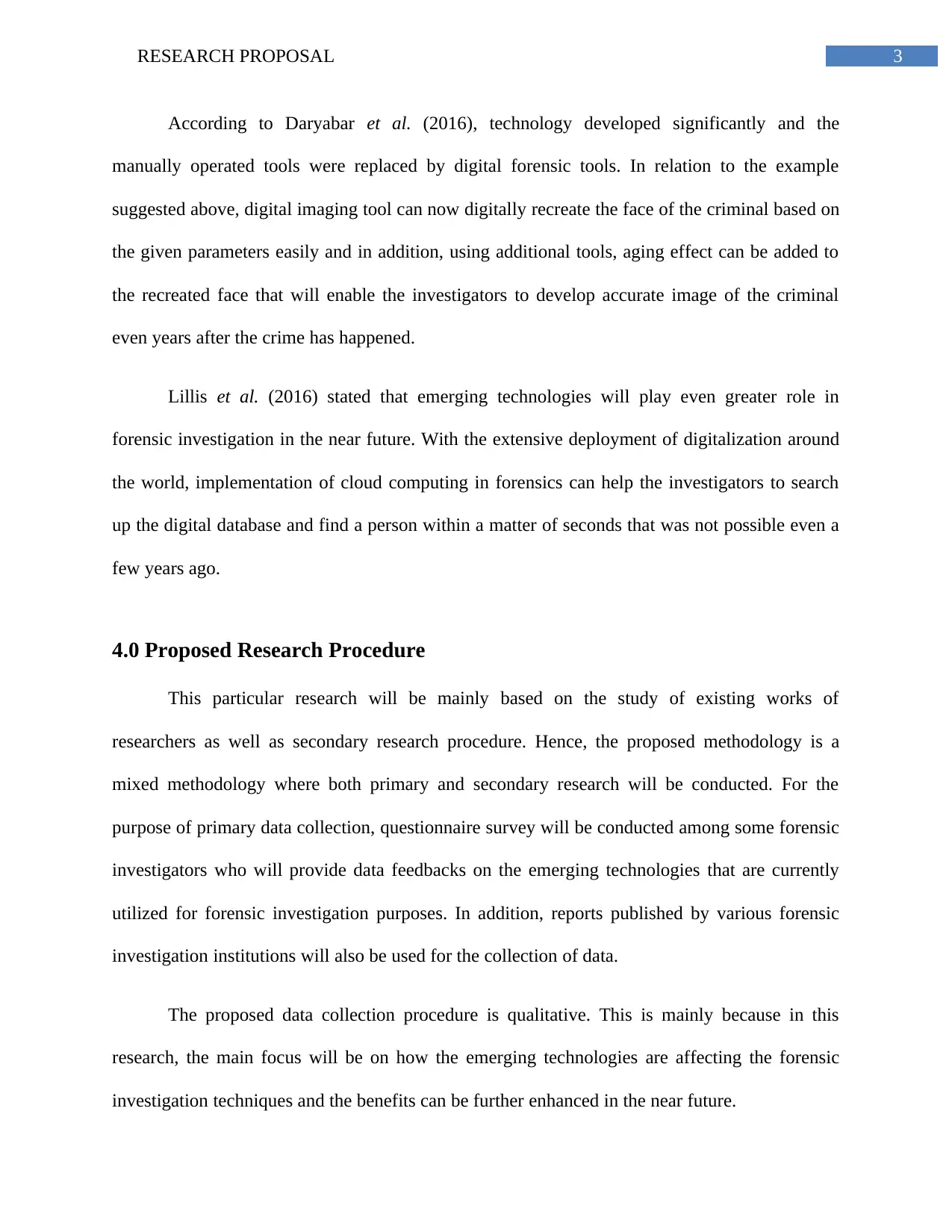
3RESEARCH PROPOSAL
According to Daryabar et al. (2016), technology developed significantly and the
manually operated tools were replaced by digital forensic tools. In relation to the example
suggested above, digital imaging tool can now digitally recreate the face of the criminal based on
the given parameters easily and in addition, using additional tools, aging effect can be added to
the recreated face that will enable the investigators to develop accurate image of the criminal
even years after the crime has happened.
Lillis et al. (2016) stated that emerging technologies will play even greater role in
forensic investigation in the near future. With the extensive deployment of digitalization around
the world, implementation of cloud computing in forensics can help the investigators to search
up the digital database and find a person within a matter of seconds that was not possible even a
few years ago.
4.0 Proposed Research Procedure
This particular research will be mainly based on the study of existing works of
researchers as well as secondary research procedure. Hence, the proposed methodology is a
mixed methodology where both primary and secondary research will be conducted. For the
purpose of primary data collection, questionnaire survey will be conducted among some forensic
investigators who will provide data feedbacks on the emerging technologies that are currently
utilized for forensic investigation purposes. In addition, reports published by various forensic
investigation institutions will also be used for the collection of data.
The proposed data collection procedure is qualitative. This is mainly because in this
research, the main focus will be on how the emerging technologies are affecting the forensic
investigation techniques and the benefits can be further enhanced in the near future.
According to Daryabar et al. (2016), technology developed significantly and the
manually operated tools were replaced by digital forensic tools. In relation to the example
suggested above, digital imaging tool can now digitally recreate the face of the criminal based on
the given parameters easily and in addition, using additional tools, aging effect can be added to
the recreated face that will enable the investigators to develop accurate image of the criminal
even years after the crime has happened.
Lillis et al. (2016) stated that emerging technologies will play even greater role in
forensic investigation in the near future. With the extensive deployment of digitalization around
the world, implementation of cloud computing in forensics can help the investigators to search
up the digital database and find a person within a matter of seconds that was not possible even a
few years ago.
4.0 Proposed Research Procedure
This particular research will be mainly based on the study of existing works of
researchers as well as secondary research procedure. Hence, the proposed methodology is a
mixed methodology where both primary and secondary research will be conducted. For the
purpose of primary data collection, questionnaire survey will be conducted among some forensic
investigators who will provide data feedbacks on the emerging technologies that are currently
utilized for forensic investigation purposes. In addition, reports published by various forensic
investigation institutions will also be used for the collection of data.
The proposed data collection procedure is qualitative. This is mainly because in this
research, the main focus will be on how the emerging technologies are affecting the forensic
investigation techniques and the benefits can be further enhanced in the near future.
Paraphrase This Document
Need a fresh take? Get an instant paraphrase of this document with our AI Paraphraser
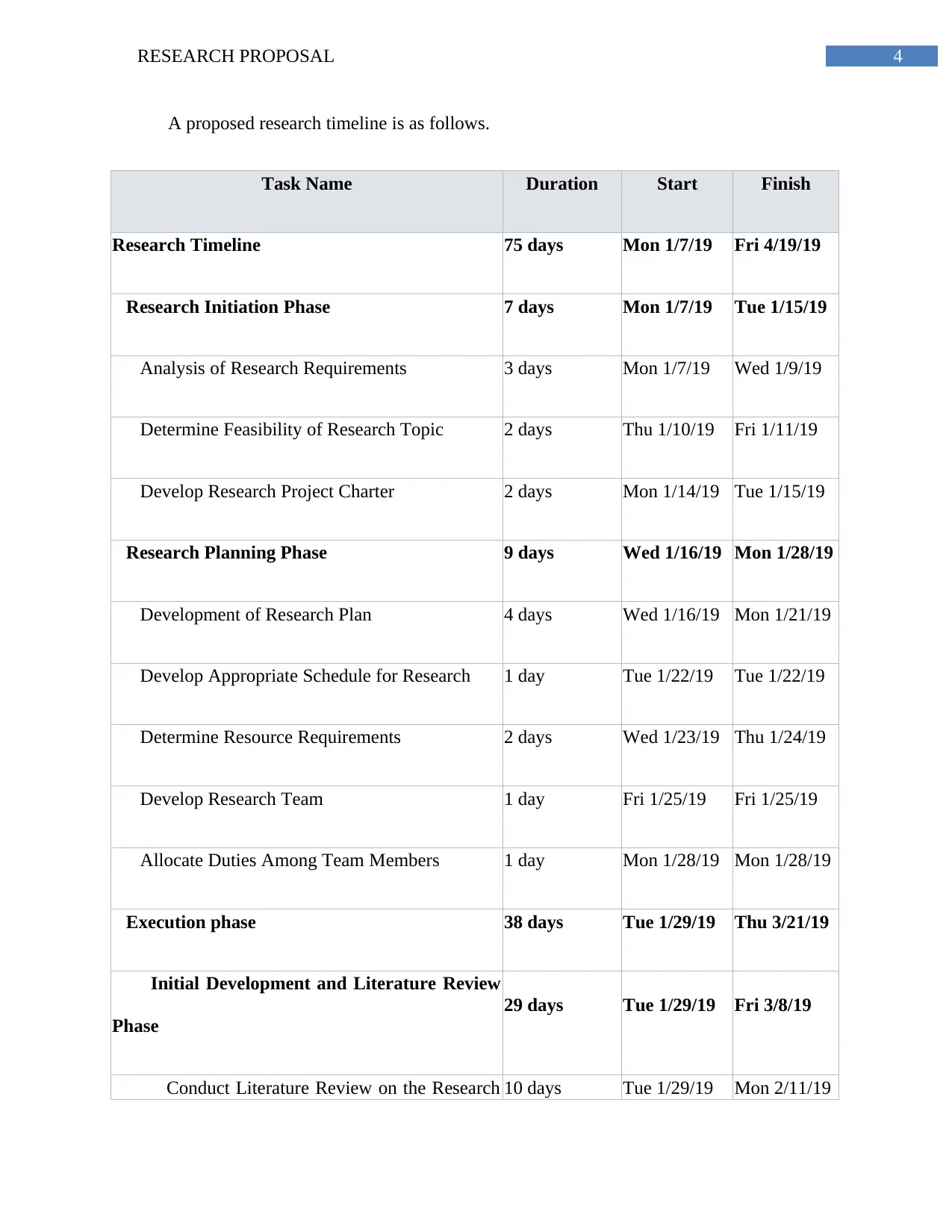
4RESEARCH PROPOSAL
A proposed research timeline is as follows.
Task Name Duration Start Finish
Research Timeline 75 days Mon 1/7/19 Fri 4/19/19
Research Initiation Phase 7 days Mon 1/7/19 Tue 1/15/19
Analysis of Research Requirements 3 days Mon 1/7/19 Wed 1/9/19
Determine Feasibility of Research Topic 2 days Thu 1/10/19 Fri 1/11/19
Develop Research Project Charter 2 days Mon 1/14/19 Tue 1/15/19
Research Planning Phase 9 days Wed 1/16/19 Mon 1/28/19
Development of Research Plan 4 days Wed 1/16/19 Mon 1/21/19
Develop Appropriate Schedule for Research 1 day Tue 1/22/19 Tue 1/22/19
Determine Resource Requirements 2 days Wed 1/23/19 Thu 1/24/19
Develop Research Team 1 day Fri 1/25/19 Fri 1/25/19
Allocate Duties Among Team Members 1 day Mon 1/28/19 Mon 1/28/19
Execution phase 38 days Tue 1/29/19 Thu 3/21/19
Initial Development and Literature Review
Phase
29 days Tue 1/29/19 Fri 3/8/19
Conduct Literature Review on the Research 10 days Tue 1/29/19 Mon 2/11/19
A proposed research timeline is as follows.
Task Name Duration Start Finish
Research Timeline 75 days Mon 1/7/19 Fri 4/19/19
Research Initiation Phase 7 days Mon 1/7/19 Tue 1/15/19
Analysis of Research Requirements 3 days Mon 1/7/19 Wed 1/9/19
Determine Feasibility of Research Topic 2 days Thu 1/10/19 Fri 1/11/19
Develop Research Project Charter 2 days Mon 1/14/19 Tue 1/15/19
Research Planning Phase 9 days Wed 1/16/19 Mon 1/28/19
Development of Research Plan 4 days Wed 1/16/19 Mon 1/21/19
Develop Appropriate Schedule for Research 1 day Tue 1/22/19 Tue 1/22/19
Determine Resource Requirements 2 days Wed 1/23/19 Thu 1/24/19
Develop Research Team 1 day Fri 1/25/19 Fri 1/25/19
Allocate Duties Among Team Members 1 day Mon 1/28/19 Mon 1/28/19
Execution phase 38 days Tue 1/29/19 Thu 3/21/19
Initial Development and Literature Review
Phase
29 days Tue 1/29/19 Fri 3/8/19
Conduct Literature Review on the Research 10 days Tue 1/29/19 Mon 2/11/19
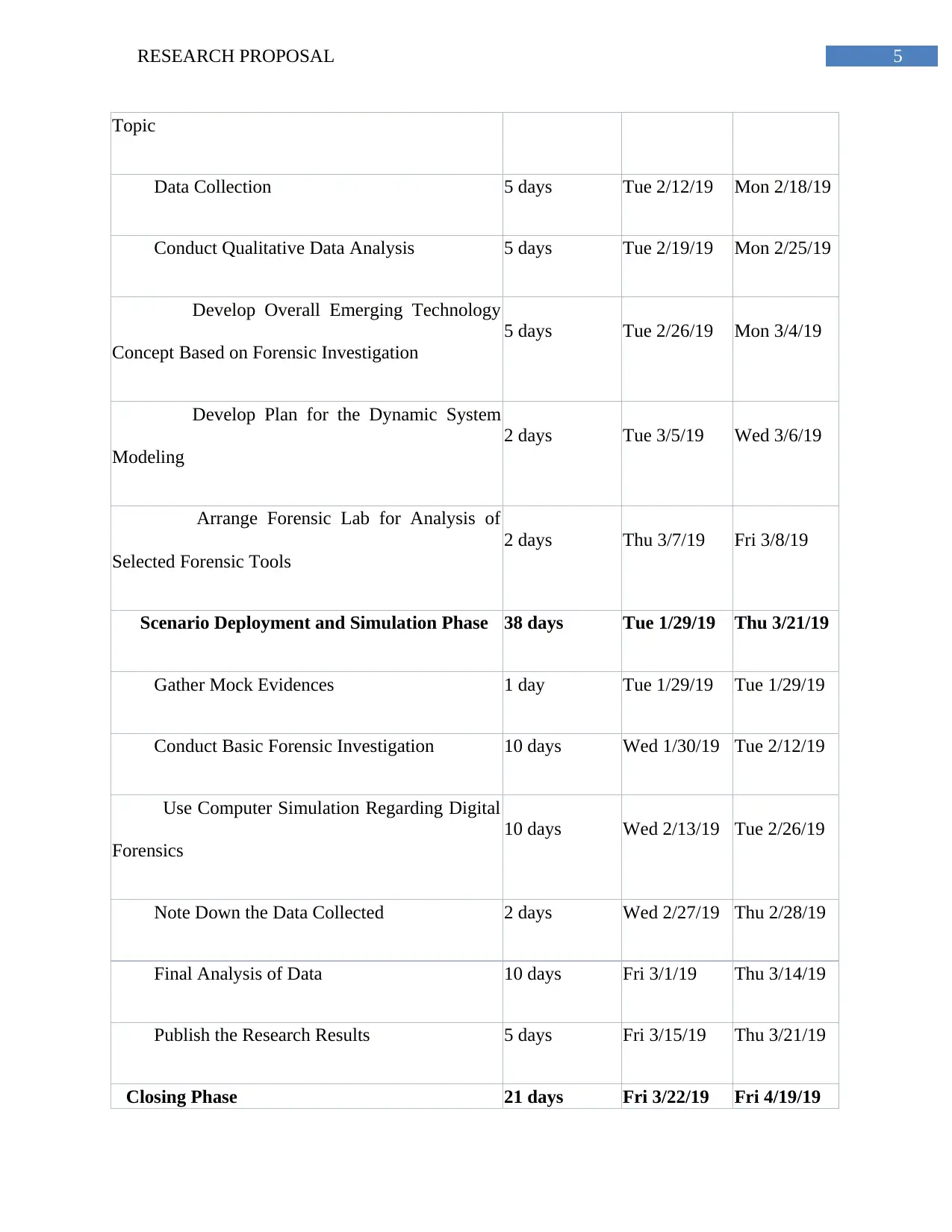
5RESEARCH PROPOSAL
Topic
Data Collection 5 days Tue 2/12/19 Mon 2/18/19
Conduct Qualitative Data Analysis 5 days Tue 2/19/19 Mon 2/25/19
Develop Overall Emerging Technology
Concept Based on Forensic Investigation
5 days Tue 2/26/19 Mon 3/4/19
Develop Plan for the Dynamic System
Modeling
2 days Tue 3/5/19 Wed 3/6/19
Arrange Forensic Lab for Analysis of
Selected Forensic Tools
2 days Thu 3/7/19 Fri 3/8/19
Scenario Deployment and Simulation Phase 38 days Tue 1/29/19 Thu 3/21/19
Gather Mock Evidences 1 day Tue 1/29/19 Tue 1/29/19
Conduct Basic Forensic Investigation 10 days Wed 1/30/19 Tue 2/12/19
Use Computer Simulation Regarding Digital
Forensics
10 days Wed 2/13/19 Tue 2/26/19
Note Down the Data Collected 2 days Wed 2/27/19 Thu 2/28/19
Final Analysis of Data 10 days Fri 3/1/19 Thu 3/14/19
Publish the Research Results 5 days Fri 3/15/19 Thu 3/21/19
Closing Phase 21 days Fri 3/22/19 Fri 4/19/19
Topic
Data Collection 5 days Tue 2/12/19 Mon 2/18/19
Conduct Qualitative Data Analysis 5 days Tue 2/19/19 Mon 2/25/19
Develop Overall Emerging Technology
Concept Based on Forensic Investigation
5 days Tue 2/26/19 Mon 3/4/19
Develop Plan for the Dynamic System
Modeling
2 days Tue 3/5/19 Wed 3/6/19
Arrange Forensic Lab for Analysis of
Selected Forensic Tools
2 days Thu 3/7/19 Fri 3/8/19
Scenario Deployment and Simulation Phase 38 days Tue 1/29/19 Thu 3/21/19
Gather Mock Evidences 1 day Tue 1/29/19 Tue 1/29/19
Conduct Basic Forensic Investigation 10 days Wed 1/30/19 Tue 2/12/19
Use Computer Simulation Regarding Digital
Forensics
10 days Wed 2/13/19 Tue 2/26/19
Note Down the Data Collected 2 days Wed 2/27/19 Thu 2/28/19
Final Analysis of Data 10 days Fri 3/1/19 Thu 3/14/19
Publish the Research Results 5 days Fri 3/15/19 Thu 3/21/19
Closing Phase 21 days Fri 3/22/19 Fri 4/19/19
⊘ This is a preview!⊘
Do you want full access?
Subscribe today to unlock all pages.

Trusted by 1+ million students worldwide
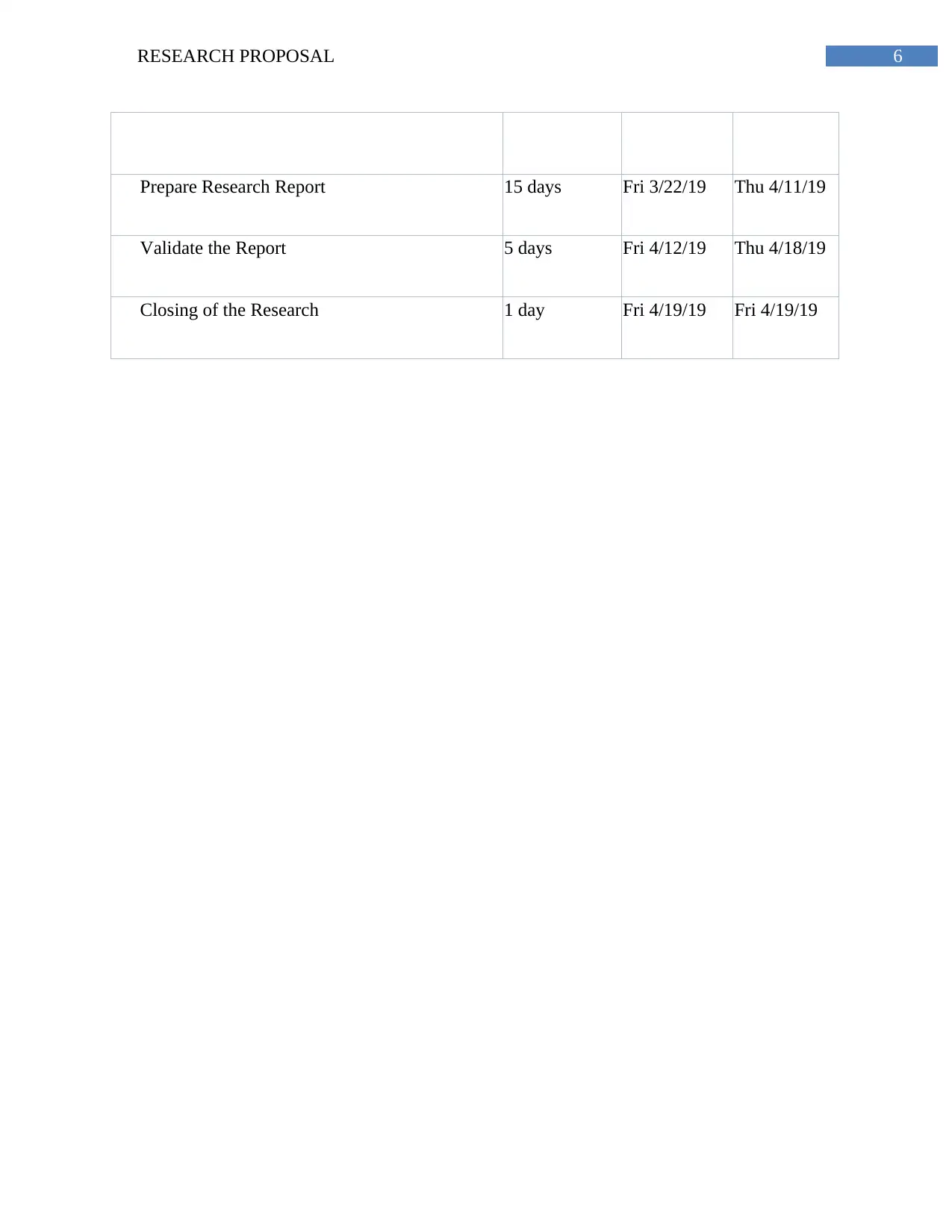
6RESEARCH PROPOSAL
Prepare Research Report 15 days Fri 3/22/19 Thu 4/11/19
Validate the Report 5 days Fri 4/12/19 Thu 4/18/19
Closing of the Research 1 day Fri 4/19/19 Fri 4/19/19
Prepare Research Report 15 days Fri 3/22/19 Thu 4/11/19
Validate the Report 5 days Fri 4/12/19 Thu 4/18/19
Closing of the Research 1 day Fri 4/19/19 Fri 4/19/19
Paraphrase This Document
Need a fresh take? Get an instant paraphrase of this document with our AI Paraphraser
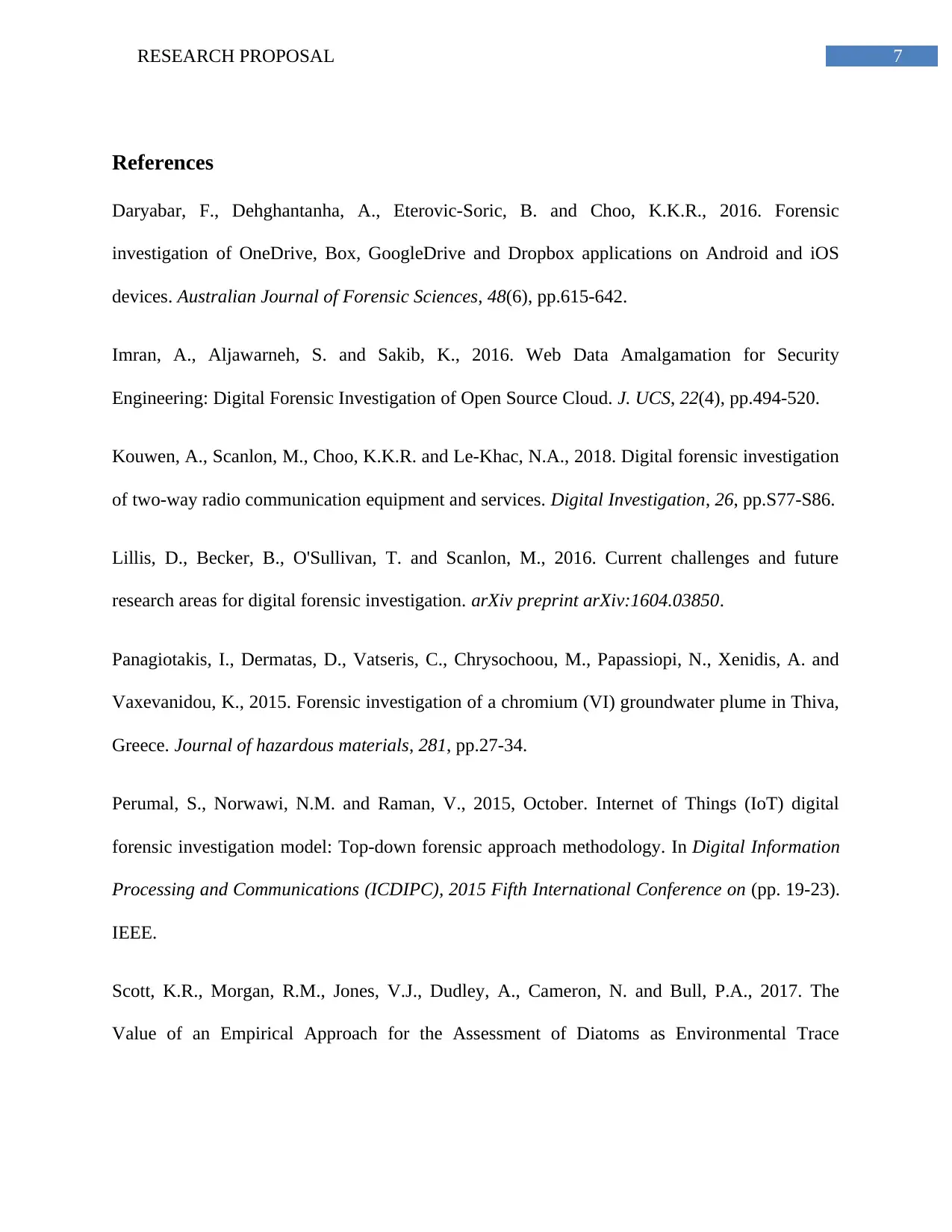
7RESEARCH PROPOSAL
References
Daryabar, F., Dehghantanha, A., Eterovic-Soric, B. and Choo, K.K.R., 2016. Forensic
investigation of OneDrive, Box, GoogleDrive and Dropbox applications on Android and iOS
devices. Australian Journal of Forensic Sciences, 48(6), pp.615-642.
Imran, A., Aljawarneh, S. and Sakib, K., 2016. Web Data Amalgamation for Security
Engineering: Digital Forensic Investigation of Open Source Cloud. J. UCS, 22(4), pp.494-520.
Kouwen, A., Scanlon, M., Choo, K.K.R. and Le-Khac, N.A., 2018. Digital forensic investigation
of two-way radio communication equipment and services. Digital Investigation, 26, pp.S77-S86.
Lillis, D., Becker, B., O'Sullivan, T. and Scanlon, M., 2016. Current challenges and future
research areas for digital forensic investigation. arXiv preprint arXiv:1604.03850.
Panagiotakis, I., Dermatas, D., Vatseris, C., Chrysochoou, M., Papassiopi, N., Xenidis, A. and
Vaxevanidou, K., 2015. Forensic investigation of a chromium (VI) groundwater plume in Thiva,
Greece. Journal of hazardous materials, 281, pp.27-34.
Perumal, S., Norwawi, N.M. and Raman, V., 2015, October. Internet of Things (IoT) digital
forensic investigation model: Top-down forensic approach methodology. In Digital Information
Processing and Communications (ICDIPC), 2015 Fifth International Conference on (pp. 19-23).
IEEE.
Scott, K.R., Morgan, R.M., Jones, V.J., Dudley, A., Cameron, N. and Bull, P.A., 2017. The
Value of an Empirical Approach for the Assessment of Diatoms as Environmental Trace
References
Daryabar, F., Dehghantanha, A., Eterovic-Soric, B. and Choo, K.K.R., 2016. Forensic
investigation of OneDrive, Box, GoogleDrive and Dropbox applications on Android and iOS
devices. Australian Journal of Forensic Sciences, 48(6), pp.615-642.
Imran, A., Aljawarneh, S. and Sakib, K., 2016. Web Data Amalgamation for Security
Engineering: Digital Forensic Investigation of Open Source Cloud. J. UCS, 22(4), pp.494-520.
Kouwen, A., Scanlon, M., Choo, K.K.R. and Le-Khac, N.A., 2018. Digital forensic investigation
of two-way radio communication equipment and services. Digital Investigation, 26, pp.S77-S86.
Lillis, D., Becker, B., O'Sullivan, T. and Scanlon, M., 2016. Current challenges and future
research areas for digital forensic investigation. arXiv preprint arXiv:1604.03850.
Panagiotakis, I., Dermatas, D., Vatseris, C., Chrysochoou, M., Papassiopi, N., Xenidis, A. and
Vaxevanidou, K., 2015. Forensic investigation of a chromium (VI) groundwater plume in Thiva,
Greece. Journal of hazardous materials, 281, pp.27-34.
Perumal, S., Norwawi, N.M. and Raman, V., 2015, October. Internet of Things (IoT) digital
forensic investigation model: Top-down forensic approach methodology. In Digital Information
Processing and Communications (ICDIPC), 2015 Fifth International Conference on (pp. 19-23).
IEEE.
Scott, K.R., Morgan, R.M., Jones, V.J., Dudley, A., Cameron, N. and Bull, P.A., 2017. The
Value of an Empirical Approach for the Assessment of Diatoms as Environmental Trace
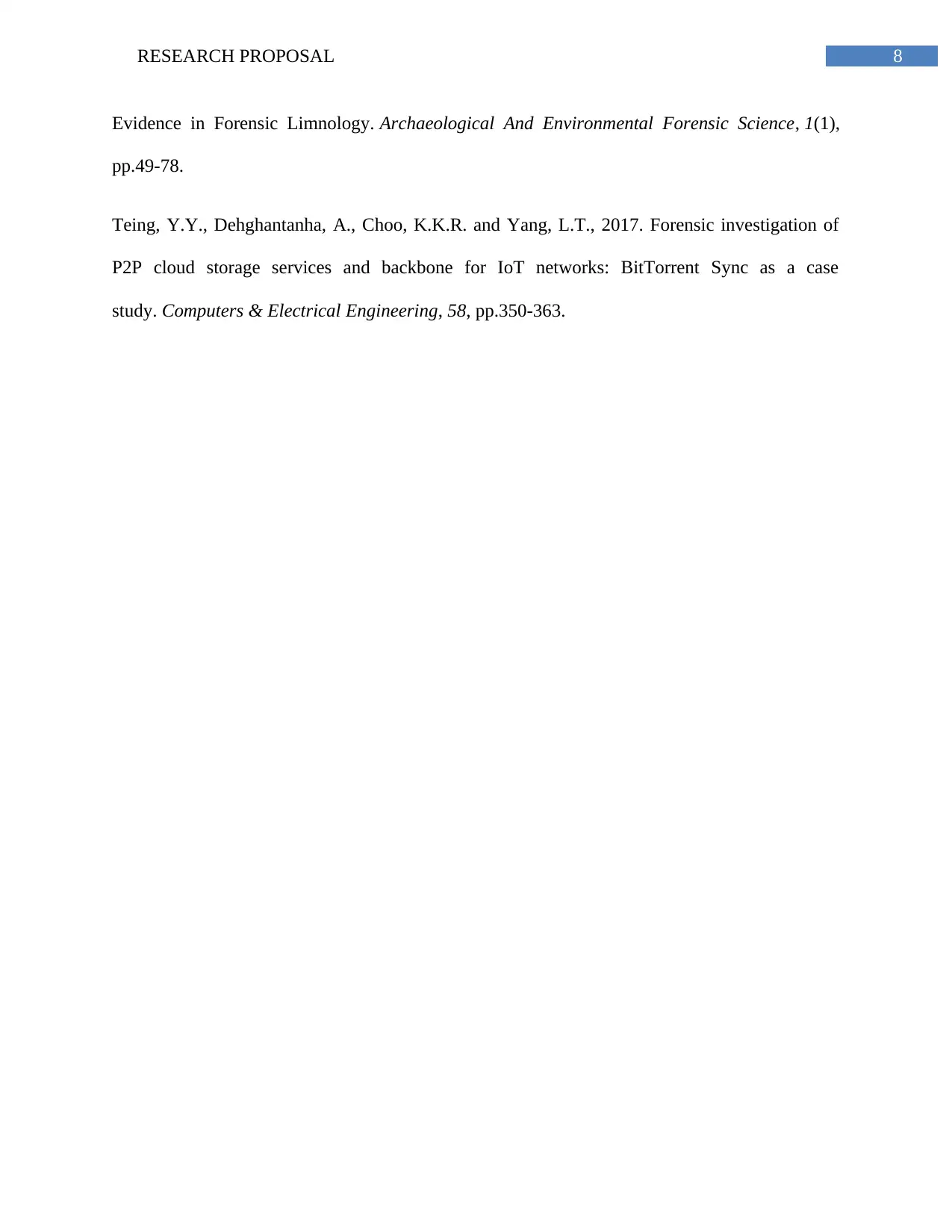
8RESEARCH PROPOSAL
Evidence in Forensic Limnology. Archaeological And Environmental Forensic Science, 1(1),
pp.49-78.
Teing, Y.Y., Dehghantanha, A., Choo, K.K.R. and Yang, L.T., 2017. Forensic investigation of
P2P cloud storage services and backbone for IoT networks: BitTorrent Sync as a case
study. Computers & Electrical Engineering, 58, pp.350-363.
Evidence in Forensic Limnology. Archaeological And Environmental Forensic Science, 1(1),
pp.49-78.
Teing, Y.Y., Dehghantanha, A., Choo, K.K.R. and Yang, L.T., 2017. Forensic investigation of
P2P cloud storage services and backbone for IoT networks: BitTorrent Sync as a case
study. Computers & Electrical Engineering, 58, pp.350-363.
⊘ This is a preview!⊘
Do you want full access?
Subscribe today to unlock all pages.

Trusted by 1+ million students worldwide
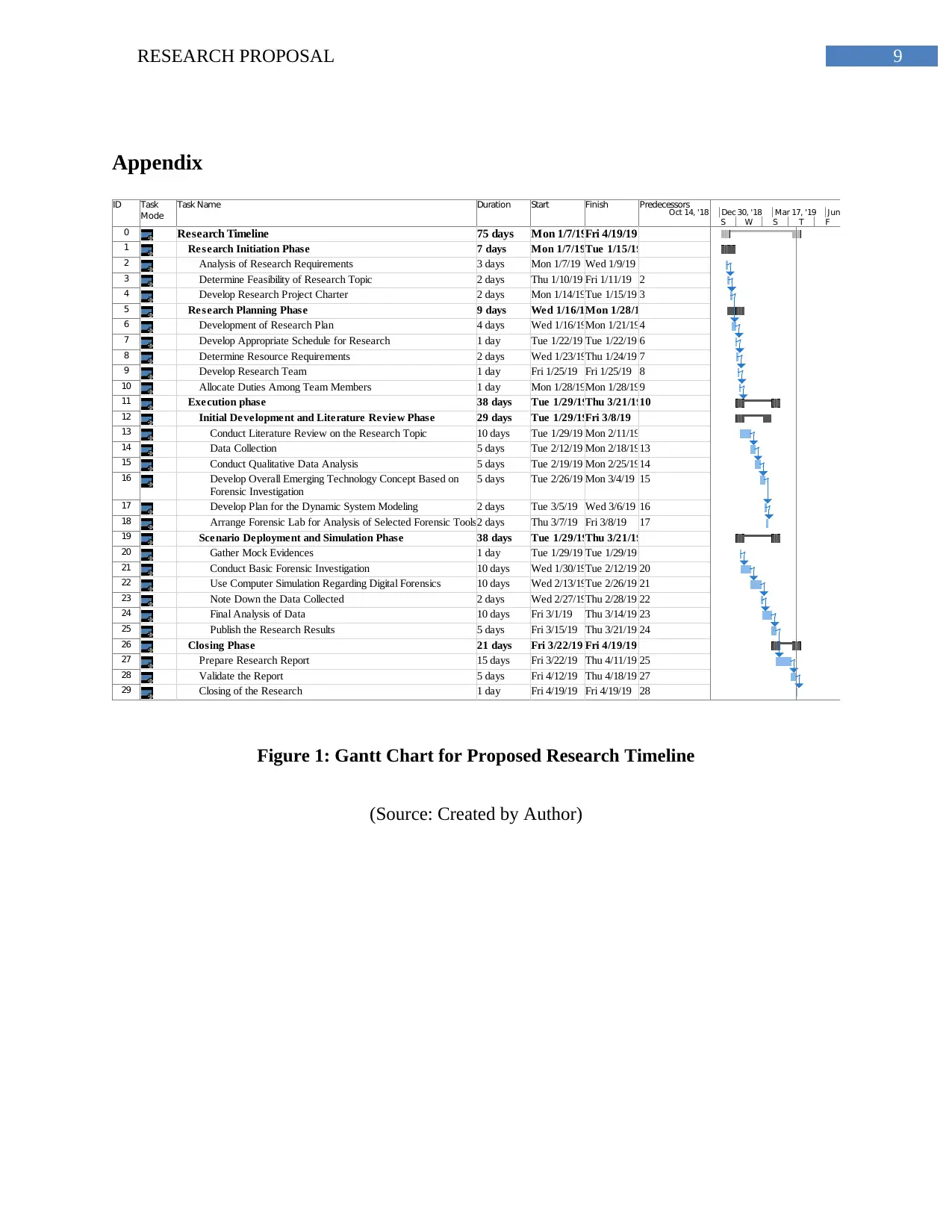
9RESEARCH PROPOSAL
Appendix
ID Task
Mode
Task Name Duration Start Finish Predecessors
0 Research Timeline 75 days Mon 1/7/19Fri 4/19/19
1 Research Initiation Phase 7 days Mon 1/7/19Tue 1/15/19
2 Analysis of Research Requirements 3 days Mon 1/7/19 Wed 1/9/19
3 Determine Feasibility of Research Topic 2 days Thu 1/10/19 Fri 1/11/19 2
4 Develop Research Project Charter 2 days Mon 1/14/19Tue 1/15/19 3
5 Research Planning Phase 9 days Wed 1/16/19Mon 1/28/19
6 Development of Research Plan 4 days Wed 1/16/19Mon 1/21/194
7 Develop Appropriate Schedule for Research 1 day Tue 1/22/19 Tue 1/22/19 6
8 Determine Resource Requirements 2 days Wed 1/23/19Thu 1/24/19 7
9 Develop Research Team 1 day Fri 1/25/19 Fri 1/25/19 8
10 Allocate Duties Among Team Members 1 day Mon 1/28/19Mon 1/28/199
11 Execution phase 38 days Tue 1/29/19Thu 3/21/1910
12 Initial Development and Literature Review Phase 29 days Tue 1/29/19Fri 3/8/19
13 Conduct Literature Review on the Research Topic 10 days Tue 1/29/19 Mon 2/11/19
14 Data Collection 5 days Tue 2/12/19 Mon 2/18/1913
15 Conduct Qualitative Data Analysis 5 days Tue 2/19/19 Mon 2/25/1914
16 Develop Overall Emerging Technology Concept Based on
Forensic Investigation
5 days Tue 2/26/19 Mon 3/4/19 15
17 Develop Plan for the Dynamic System Modeling 2 days Tue 3/5/19 Wed 3/6/19 16
18 Arrange Forensic Lab for Analysis of Selected Forensic Tools2 days Thu 3/7/19 Fri 3/8/19 17
19 Scenario Deployment and Simulation Phase 38 days Tue 1/29/19Thu 3/21/19
20 Gather Mock Evidences 1 day Tue 1/29/19 Tue 1/29/19
21 Conduct Basic Forensic Investigation 10 days Wed 1/30/19Tue 2/12/19 20
22 Use Computer Simulation Regarding Digital Forensics 10 days Wed 2/13/19Tue 2/26/19 21
23 Note Down the Data Collected 2 days Wed 2/27/19Thu 2/28/19 22
24 Final Analysis of Data 10 days Fri 3/1/19 Thu 3/14/19 23
25 Publish the Research Results 5 days Fri 3/15/19 Thu 3/21/19 24
26 Closing Phase 21 days Fri 3/22/19 Fri 4/19/19
27 Prepare Research Report 15 days Fri 3/22/19 Thu 4/11/19 25
28 Validate the Report 5 days Fri 4/12/19 Thu 4/18/19 27
29 Closing of the Research 1 day Fri 4/19/19 Fri 4/19/19 28
S W S T F
Oct 14, '18 Dec 30, '18 Mar 17, '19 Jun 2, '19
Figure 1: Gantt Chart for Proposed Research Timeline
(Source: Created by Author)
Appendix
ID Task
Mode
Task Name Duration Start Finish Predecessors
0 Research Timeline 75 days Mon 1/7/19Fri 4/19/19
1 Research Initiation Phase 7 days Mon 1/7/19Tue 1/15/19
2 Analysis of Research Requirements 3 days Mon 1/7/19 Wed 1/9/19
3 Determine Feasibility of Research Topic 2 days Thu 1/10/19 Fri 1/11/19 2
4 Develop Research Project Charter 2 days Mon 1/14/19Tue 1/15/19 3
5 Research Planning Phase 9 days Wed 1/16/19Mon 1/28/19
6 Development of Research Plan 4 days Wed 1/16/19Mon 1/21/194
7 Develop Appropriate Schedule for Research 1 day Tue 1/22/19 Tue 1/22/19 6
8 Determine Resource Requirements 2 days Wed 1/23/19Thu 1/24/19 7
9 Develop Research Team 1 day Fri 1/25/19 Fri 1/25/19 8
10 Allocate Duties Among Team Members 1 day Mon 1/28/19Mon 1/28/199
11 Execution phase 38 days Tue 1/29/19Thu 3/21/1910
12 Initial Development and Literature Review Phase 29 days Tue 1/29/19Fri 3/8/19
13 Conduct Literature Review on the Research Topic 10 days Tue 1/29/19 Mon 2/11/19
14 Data Collection 5 days Tue 2/12/19 Mon 2/18/1913
15 Conduct Qualitative Data Analysis 5 days Tue 2/19/19 Mon 2/25/1914
16 Develop Overall Emerging Technology Concept Based on
Forensic Investigation
5 days Tue 2/26/19 Mon 3/4/19 15
17 Develop Plan for the Dynamic System Modeling 2 days Tue 3/5/19 Wed 3/6/19 16
18 Arrange Forensic Lab for Analysis of Selected Forensic Tools2 days Thu 3/7/19 Fri 3/8/19 17
19 Scenario Deployment and Simulation Phase 38 days Tue 1/29/19Thu 3/21/19
20 Gather Mock Evidences 1 day Tue 1/29/19 Tue 1/29/19
21 Conduct Basic Forensic Investigation 10 days Wed 1/30/19Tue 2/12/19 20
22 Use Computer Simulation Regarding Digital Forensics 10 days Wed 2/13/19Tue 2/26/19 21
23 Note Down the Data Collected 2 days Wed 2/27/19Thu 2/28/19 22
24 Final Analysis of Data 10 days Fri 3/1/19 Thu 3/14/19 23
25 Publish the Research Results 5 days Fri 3/15/19 Thu 3/21/19 24
26 Closing Phase 21 days Fri 3/22/19 Fri 4/19/19
27 Prepare Research Report 15 days Fri 3/22/19 Thu 4/11/19 25
28 Validate the Report 5 days Fri 4/12/19 Thu 4/18/19 27
29 Closing of the Research 1 day Fri 4/19/19 Fri 4/19/19 28
S W S T F
Oct 14, '18 Dec 30, '18 Mar 17, '19 Jun 2, '19
Figure 1: Gantt Chart for Proposed Research Timeline
(Source: Created by Author)
1 out of 10
Related Documents
Your All-in-One AI-Powered Toolkit for Academic Success.
+13062052269
info@desklib.com
Available 24*7 on WhatsApp / Email
![[object Object]](/_next/static/media/star-bottom.7253800d.svg)
Unlock your academic potential
Copyright © 2020–2025 A2Z Services. All Rights Reserved. Developed and managed by ZUCOL.





